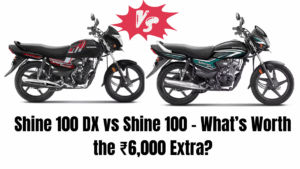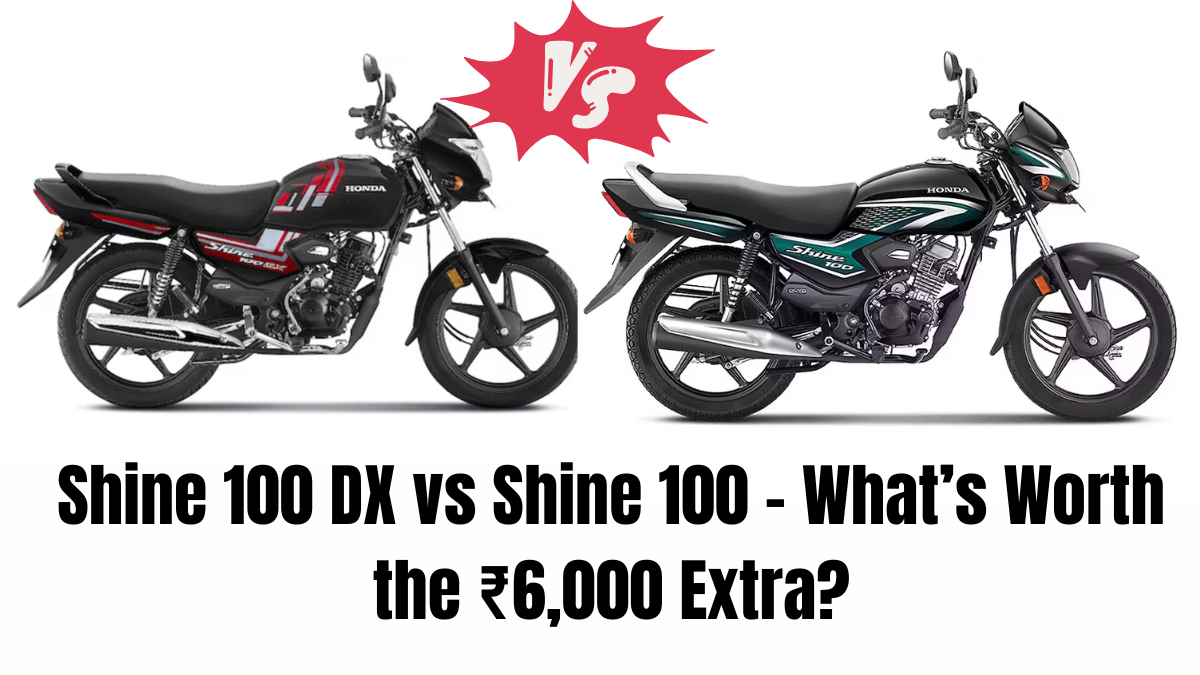Honda’s Shine series continues to dominate the commuter bike segment in India, with the Shine 100 DX emerging as an upgraded sibling to the popular Shine 100. Priced approximately ₹6,000 higher, the Shine 100 DX promises enhancements in features and styling. This article presents an in-depth comparison between the Shine 100 DX and the Shine 100 for 2025, helping buyers decide whether the extra investment is justified by the improvements and benefits offered.

Price Comparison
The Shine 100 DX starts at around ₹74,959 (ex-showroom), whereas the Shine 100 is priced slightly lower, making the DX about ₹6,000 more expensive. This price difference may seem marginal, but buyers need to assess what additional value they receive for this amount.
Feature Differences
The Shine 100 DX comes with several notable upgrades over the Shine 100:
-
LCD Instrument Cluster: Unlike the analog cluster on the Shine 100, the DX variant features a fully digital LCD display offering clearer and more detailed ride information.
-
Tubeless Tyres: The DX is equipped with tubeless tyres, which reduce puncture risks and simplify repairs, whereas the Shine 100 typically comes with tube tyres.
-
LED Lighting: The DX boasts energy-efficient LED headlamps and taillights, improving nighttime visibility and style; the Shine 100 retains halogen bulbs.
-
Chrome Accents: The Shine 100 DX has premium chrome detailing on exhaust and mirrors, adding a more polished look compared to the Shine 100.
These enhancements collectively elevate the DX variant’s aesthetics and functionality.
Performance and Ride Quality
Both bikes share the same engine configuration—a 97.2cc, air-cooled single-cylinder four-stroke motor producing similar power (around 7.91 PS) and torque figures. The ride comfort and handling remain largely consistent across both models, with telescopic front suspension and twin rear shocks.
However, the tubeless tyres on the DX can offer improved ride stability and safety, particularly over rough urban roads.
Fuel Efficiency
Fuel economy is a critical factor in this segment. Both Shine 100 and Shine 100 DX deliver similar mileage, averaging around 65-70 kmpl depending on riding conditions. The added features on the DX variant do not significantly impact fuel efficiency, making it an equally economical choice.
Maintenance and Ownership Costs
Maintenance costs for both models remain low, benefiting from Honda’s extensive service network. Tubeless tyres on the DX might reduce service visits related to punctures and tyre changes, providing slight savings in the long run.
Who Should Choose Shine 100 DX?
-
Buyers seeking modern tech upgrades like an LCD cluster and LED lighting
-
Riders who prioritize better tyre technology and improved safety
-
Customers wanting a fresh, stylish look with chrome accents
-
Those willing to pay a slight premium for enhanced features and aesthetics
Who Should Stick to Shine 100?
-
Budget basic features without the added premium touches
-
Those looking for a no-frills, dependable commuter bike at a lower price point
Final Verdict
The Shine 100 DX offers meaningful upgrades over the Shine 100, including a modern LCD instrument cluster, tubeless tyres, LED lighting, and enhanced styling with chrome accents. These features improve safety, convenience, and aesthetics, justifying the ₹6,000 premium for many buyers. However, if budget constraints are tight and you prioritize basic reliable performance, the standard Shine 100 remains an excellent choice, maintaining Honda’s hallmark durability and fuel efficiency.
Ultimately, your choice depends on whether you value the additional tech and style enhancements or prefer to save on upfront cost while enjoying similar engine performance and mileage.
FAQs
What is the price difference between Shine 100 DX and Shine 100?
The Shine 100 DX costs about ₹6,000 more than the Shine 100 ex-showroom.
Does Shine 100 DX have better lighting than Shine 100?
Yes, Shine 100 DX features LED headlamps and taillights, whereas Shine 100 uses halogen bulbs.
Are tubeless tyres standard on Shine 100 DX?
Yes, Shine 100 DX comes with tubeless tyres, while Shine 100 has tube tyres.
Is the instrument cluster digital on both models?
No, only Shine 100 DX has a digital LCD instrument cluster; Shine 100 uses analog dials.
Do both bikes have the same engine performance?
Yes, both have the same 97.2cc engine with similar power and torque outputs.
